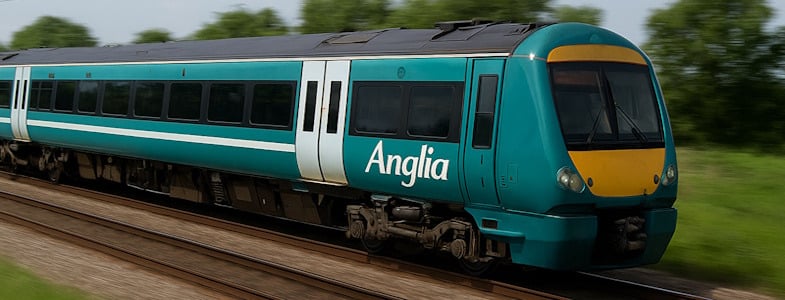
Overview
Anglia Railways was a UK train operating company that ran passenger services in East Anglia from January 1997 until April 2004. It operated under a franchise awarded by the newly created Strategic Rail Authority after British Rail’s privatisation. The company was owned by GB Railways, an independent operator at the time, and quickly established a reputation for reliability and a distinct identity with its turquoise and white livery.
History
The Anglia Railways franchise began operations in 1997, taking over routes formerly run by British Rail’s InterCity and Network SouthEast sectors in East Anglia. GB Railways invested heavily in improving customer service and modernising its operations, which helped boost the company’s standing during the early years of rail privatisation. In 2003, the franchise was transferred to National Express, which rebranded the network as ‘One’ Railway in 2004, marking the end of Anglia Railways as a standalone brand.
Network & Routes
Anglia Railways served much of East Anglia, with its flagship services running between London Liverpool Street and Norwich. Additional routes connected Great Yarmouth, Lowestoft, Sheringham, and Ipswich, linking both rural and coastal areas of Norfolk and Suffolk to London and regional hubs. Services also extended to Cambridge, Peterborough, and Stansted Airport, making it a vital operator for both commuters and leisure travellers.
Fleet & Onboard Facilities
The fleet included Class 86 electric locomotives with Mark 2 coaching stock for long-distance London–Norwich services, as well as Class 150 and 153 diesel multiple units inherited from British Rail for regional routes. To modernise the network, Anglia Railways introduced Class 170 Turbostar units, which provided improved comfort, reliability, and speed on regional and intercity services. Facilities varied by train type, with longer services offering First Class, at-seat trolley catering, and later improvements such as modernised interiors.
Travel Information
Tickets included Advance, Saver, and Walk-Up fares, in line with the wider national system of the late 1990s and early 2000s. Seat reservations were available on intercity services, with First Class offering larger seats and complimentary extras. Anglia Railways promoted itself as a customer-focused operator, often running special offers and marketing campaigns aimed at leisure travel to East Anglia’s seaside towns.
Performance & Reputation
Anglia Railways developed a reputation for clean trains, friendly staff, and an easily recognisable brand identity. It played an important role in maintaining direct rail services between Norwich and London during a period of wider rail industry change. However, challenges included ageing rolling stock in some areas and competition for passengers on commuter routes into London. The franchise’s absorption into National Express’s operations in 2004 marked the end of its independent identity, but the turquoise branding is still fondly remembered by many enthusiasts.
Did You Know?
Anglia Railways was one of the first post-privatisation operators not owned by a multinational transport company, but by GB Railways, a smaller independent firm.
The Class 170 Turbostar units introduced by Anglia Railways were later used by successor operators across the UK.
The turquoise livery became iconic and stood out strongly compared to other post-privatisation brands.
Anglia Railways Archived Timetables
All files listed below are in compressed format and will need to be unpacked with an archiving program, we recommend 7-Zip which is completely free and can be downloaded from here.
Anglia Railways Network Map
Related Searches
Anglia Railways Delay Repay
Anglia Railways operated their franchise before Delay Repay was introduced on the British Railway network....
Anglia Railways Hare Fares
Hare Fares are a newer offering from the current franchise operator Greater Anglia although there may....
Anglia Railways Bikes
Anglia Railways claimed to 'revolutionise' travel for those with bikes with the introduction of reservations....
Anglia Railways WAP Service
Anglia Railways offered a WAP internet service which allowed passengers to view arrivals and departures....
Anglia Railways Menu
Anglia Railways provided an on-board restaurant service offering staples such as the Great British Breakfast and...
Anglia Railways Business Travel
Anglia Railways provided a dedicated Business Travel contact line. This enabled travellers to purchase a wide...
Anglia Railways Group Travel
Parties of ten or more were able to take advantage of significant discounts on many types of ticket offered....
Anglia Railways Lost Property
Anglia Railways operated lost property offices at both Norwich and London Liverpool Street. Passengers were...



